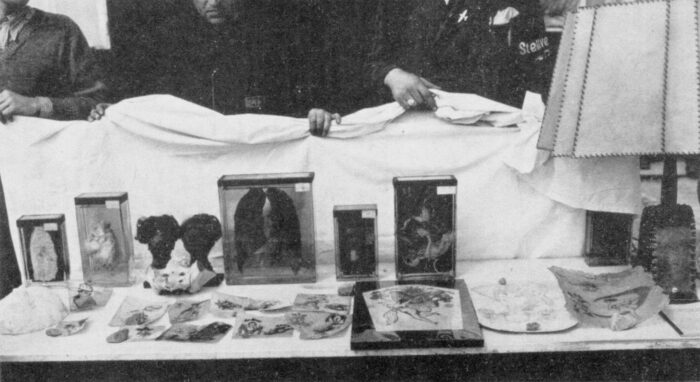Lampshades, of Human Skin
There are plenty of photographs and film footage of tattooed human skin, allegedly taken from deceased or murdered inmates of German wartime camps. Especially famous is film footage recorded by U.S. troops after liberating the Buchenwald Camp. They had set up a table there, onto which they had arranged all kinds of objects which were allegedly made of dead or murdered inmates: soap, a table lamp, two shrunken heads, tattooed skin etc. The local population was forced to walk by this table for “educational purposes.” It was an operation staged by the United States’ psychological warfare department (see Irebodd 2009). The scenes were filmed and later used to further “re-educate” the German populace by showing this footage all over the country in cinemas. If Germans did not watch these “documentaries,” the Allied authorities would deny them food stamps, which for many were pivotal for survival in the immediate post-war years.

This “documentary” and the objects, as well as an expert report by a pathologist of the U.S. Army of May 1946, served later as evidence during the Dachau show trial against the staff of the Buchenwald Camp, and during the trials of Ilse Koch, the wife of the former camp commandant of the Buchenwald Camp. She is supposed to have selected living prisoners in the camp according to their tattooing and designated them for killing in order to have household objects produced from their skin.
In an interview that SS judge Konrad Morgen granted the British historian John Toland years after the war, he insisted that the stories about Ilse Koch using tattooed human skin for lampshades and other object were unfounded legends. He had searched the Koch household himself during the war when investigating crimes committed by Ilse’s husband Karl-Otto Koch, former commandant of the Buchenwald Camp, without finding any such objects. (See Toland 1976, pp. 845f.)
In a detailed study, U.S. mainstream author Arthur L. Smith determined that the objects identified as human skin by a U.S. examination, after they were sent to the International Military Tribunal at Nuremberg, disappeared without a trace (Smith 1983, pp. 103, 138, 153, 164). According to the statement of General Clay of the U.S. Army, the alleged human-skin lampshades are supposed to have consisted of goatskin (ibid., p. 227; but see also the Buchenwald Museum at www.buchenwald.de, citing two “trustworthy” witnesses for the existence of such a lamp, although they claim that it was conveniently destroyed without a trace already in late 1941). All other objects found later were either made of synthetic leather, animal leather, textile or cardboard.
The story may have had a real background, though, as Smith reports. There evidently was a medical student from the University of Jena during the war period who was doing his medical dissertation on the correlation between skin tattooing and criminality (Smith 1983, pp. 127f.), which then was briefly touched upon in yet another PhD thesis some 65 years later on the history of forensic medicine at the University of Jena (Bode 2007, pp. 106f.).
The trials against Ilse Koch were the worst examples of the many show trials conducted after World War Two against alleged “Nazi criminals,” which have a shocking resemblance to medieval witch trials.
(For more details, see Rudolf 2023, pp. 94-97; see also the entry on Hans Maršálek.)

You need to be a registered user, logged into your account, and your comment must comply with our Acceptable Use Policy, for your comment to get published. (Click here to log in or register.)